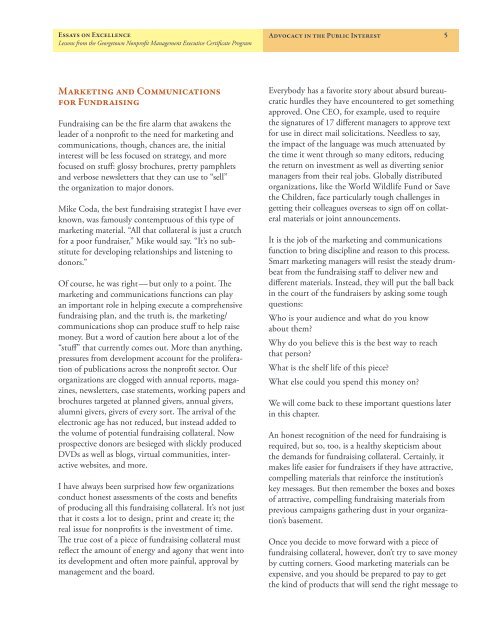Nonprofit Marketing
Nonprofit Marketing
Nonprofit Marketing
You also want an ePaper? Increase the reach of your titles
YUMPU automatically turns print PDFs into web optimized ePapers that Google loves.
Essays on Excellence<br />
Lessons from the Georgetown <strong>Nonprofit</strong> Management Executive Certificate Program<br />
Advocacy in the Public Interest 5<br />
<strong>Marketing</strong> and Communications<br />
for Fundraising<br />
Fundraising can be the fire alarm that awakens the<br />
leader of a nonprofit to the need for marketing and<br />
communications, though, chances are, the initial<br />
interest will be less focused on strategy, and more<br />
focused on stuff: glossy brochures, pretty pamphlets<br />
and verbose newsletters that they can use to “sell”<br />
the organization to major donors.<br />
Mike Coda, the best fundraising strategist I have ever<br />
known, was famously contemptuous of this type of<br />
marketing material. “All that collateral is just a crutch<br />
for a poor fundraiser,” Mike would say. “It’s no substitute<br />
for developing relationships and listening to<br />
donors.”<br />
Of course, he was right — but only to a point. The<br />
marketing and communications functions can play<br />
an important role in helping execute a comprehensive<br />
fundraising plan, and the truth is, the marketing/<br />
communications shop can produce stuff to help raise<br />
money. But a word of caution here about a lot of the<br />
“stuff” that currently comes out. More than anything,<br />
pressures from development account for the proliferation<br />
of publications across the nonprofit sector. Our<br />
organizations are clogged with annual reports, magazines,<br />
newsletters, case statements, working papers and<br />
brochures targeted at planned givers, annual givers,<br />
alumni givers, givers of every sort. The arrival of the<br />
electronic age has not reduced, but instead added to<br />
the volume of potential fundraising collateral. Now<br />
prospective donors are besieged with slickly produced<br />
DVDs as well as blogs, virtual communities, interactive<br />
websites, and more.<br />
I have always been surprised how few organizations<br />
conduct honest assessments of the costs and benefits<br />
of producing all this fundraising collateral. It’s not just<br />
that it costs a lot to design, print and create it; the<br />
real issue for nonprofits is the investment of time.<br />
The true cost of a piece of fundraising collateral must<br />
reflect the amount of energy and agony that went into<br />
its development and often more painful, approval by<br />
management and the board.<br />
Everybody has a favorite story about absurd bureaucratic<br />
hurdles they have encountered to get something<br />
approved. One CEO, for example, used to require<br />
the signatures of 17 different managers to approve text<br />
for use in direct mail solicitations. Needless to say,<br />
the impact of the language was much attenuated by<br />
the time it went through so many editors, reducing<br />
the return on investment as well as diverting senior<br />
managers from their real jobs. Globally distributed<br />
organizations, like the World Wildlife Fund or Save<br />
the Children, face particularly tough challenges in<br />
getting their colleagues overseas to sign off on collateral<br />
materials or joint announcements.<br />
It is the job of the marketing and communications<br />
function to bring discipline and reason to this process.<br />
Smart marketing managers will resist the steady drumbeat<br />
from the fundraising staff to deliver new and<br />
different materials. Instead, they will put the ball back<br />
in the court of the fundraisers by asking some tough<br />
questions:<br />
Who is your audience and what do you know<br />
about them?<br />
Why do you believe this is the best way to reach<br />
that person?<br />
What is the shelf life of this piece?<br />
What else could you spend this money on?<br />
We will come back to these important questions later<br />
in this chapter.<br />
An honest recognition of the need for fundraising is<br />
required, but so, too, is a healthy skepticism about<br />
the demands for fundraising collateral. Certainly, it<br />
makes life easier for fundraisers if they have attractive,<br />
compelling materials that reinforce the institution’s<br />
key messages. But then remember the boxes and boxes<br />
of attractive, compelling fundraising materials from<br />
previous campaigns gathering dust in your organization’s<br />
basement.<br />
Once you decide to move forward with a piece of<br />
fundraising collateral, however, don’t try to save money<br />
by cutting corners. Good marketing materials can be<br />
expensive, and you should be prepared to pay to get<br />
the kind of products that will send the right message to

















